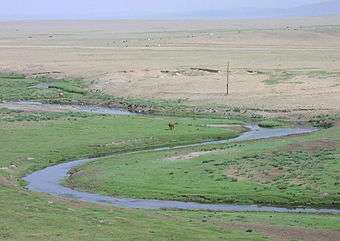Mongolian-Manchurian grassland

.jpg)
The Mongolian-Manchurian grassland ecoregion, also known as the Mongolian-Manchurian steppe, in the temperate grassland Biome, is found in Mongolia, the Chinese Autonomous region of Inner Mongolia and northeastern China.
Setting
The Mongolian-Manchurian grassland covers an area of 887,300 square kilometers (342,600 sq mi). This Palearctic temperate grasslands, savannas, and shrublands ecoregion of the Temperate grasslands, savannas, and shrublands Biome, forms a large crescent around the Gobi Desert, extending across central and eastern Mongolia into the eastern portion of Inner Mongolia and eastern and central Manchuria, and then southwest across the North China Plain. To the northeast and north, the Selenge-Orkhon and Daurian forest steppes form a transition zone between the grassland and the forests of Siberia to the north. On the east and southeast, the grasslands transition to temperate broadleaf and mixed forests, including the Manchurian mixed forests, Northeast China Plain deciduous forests, and Central China loess plateau mixed forests. On the southwest, the grasslands extend to the Yellow River, across which is the Ordos Plateau steppe.
The law of the steppes allowed people to take what they wished - but that insured fighting between tribes. The history of Genghis Khan records that he believed one cannot fight a battle one cannot win. On the other hand, a determined person can accomplish great things.[1]
Flora
The dominant flora consists of medium to tall grasslands, dominated by feather grass (Stipa baicalensis, S. capillata, and S. grandis), sheep's fescue (Festuca ovina), Aneurolepidium chinense, Filifolium sibiricuman, and Cleistogenes sqarrosa. The drier regions surrounding the Gobi host drought-tolerant grasses, together with forbs and low, spiny shrubs.
The southwestern slopes of the Greater Khingan range support pockets of broadleaf deciduous forest, of either Mongolian oak (Quercus mongolica), or a mixture of poplar (Populus davidiana and P. suaveolens), Siberian silver birch (Betula platyphylla), and willow (Salix rorida).
Fauna
- The brown eared-pheasant (Crossoptilon mantchuricum) is the sole endemic bird in the ecoregion.
- The bobak marmot (Marmota bobak), also known as the steppe marmot, inhabits the area
- The gray wolf lives here.
- The Mongolian gazelle is numerous here.
- The Przewalski's horse is reintroduced here.
- The corsac fox
- eagles
Conservation and threats
The Mongolian-Manchurian grassland faces threat from human expansion, though in most of its eastern area, it has not been altered by agriculture as much as its reaches in western Asia, or similar grasslands in North America.[2][3]
References
- ↑ "Genghis Khan - Life on the Steppes". AwesomeStories.com. Retrieved 2018-01-10.
- ↑ Environment in East Asia & Pacific
- ↑ "Structure of threats to steppe biome in Russia - Conservation of steppes in Russia".
External links
- "Mongolian-Manchurian grassland". Terrestrial Ecoregions. World Wildlife Fund.
| Alai-Western Tian Shan steppe | Kazakhstan, Tajikistan, Uzbekistan |
| Altai steppe and semi-desert | Kazakhstan |
| Central Anatolian steppe | Turkey |
| Daurian forest steppe | China, Mongolia, Russia |
| Eastern Anatolian montane steppe | Armenia, Iran, Turkey |
| Emin Valley steppe | China, Kazakhstan |
| Faroe Islands boreal grasslands | Faroe Islands, Denmark |
| Gissaro-Alai open woodlands | Kyrgyzstan, Tajikistan, Uzbekistan |
| Kazakh forest steppe | Kazakhstan, Russia |
| Kazakh steppe | Kazakhstan, Russia |
| Kazakh Uplands | Kazakhstan |
| Middle East steppe | Iraq, Syria |
| Mongolian-Manchurian grassland | China, Mongolia, Russia |
| Pontic steppe | Kazakhstan, Moldova, Romania, Russia, Ukraine, Bulgaria |
| Sayan Intermontane steppe | Russia |
| Selenge-Orkhon forest steppe | Mongolia, Russia |
| South Siberian forest steppe | Russia |
| Tian Shan foothill arid steppe | China, Kazakhstan, Kyrgyzstan |